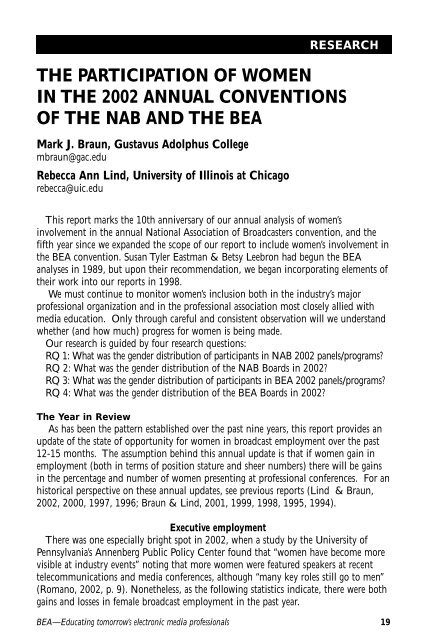APRILFeedback
Feedback April 2003 (Vol. 44, No. 2) - Broadcast Education ...
Feedback April 2003 (Vol. 44, No. 2) - Broadcast Education ...
- No tags were found...
You also want an ePaper? Increase the reach of your titles
YUMPU automatically turns print PDFs into web optimized ePapers that Google loves.
RESEARCHTHE PARTICIPATION OF WOMENIN THE 2002 ANNUAL CONVENTIONSOF THE NAB AND THE BEAMark J. Braun, Gustavus Adolphus Collegembraun@gac.eduRebecca Ann Lind, University of Illinois at Chicagorebecca@uic.eduThis report marks the 10th anniversary of our annual analysis of women’sinvolvement in the annual National Association of Broadcasters convention, and thefifth year since we expanded the scope of our report to include women’s involvement inthe BEA convention. Susan Tyler Eastman & Betsy Leebron had begun the BEAanalyses in 1989, but upon their recommendation, we began incorporating elements oftheir work into our reports in 1998.We must continue to monitor women’s inclusion both in the industry’s majorprofessional organization and in the professional association most closely allied withmedia education. Only through careful and consistent observation will we understandwhether (and how much) progress for women is being made.Our research is guided by four research questions:RQ 1: What was the gender distribution of participants in NAB 2002 panels/programs?RQ 2: What was the gender distribution of the NAB Boards in 2002?RQ 3: What was the gender distribution of participants in BEA 2002 panels/programs?RQ 4: What was the gender distribution of the BEA Boards in 2002?The Year in ReviewAs has been the pattern established over the past nine years, this report provides anupdate of the state of opportunity for women in broadcast employment over the past12-15 months. The assumption behind this annual update is that if women gain inemployment (both in terms of position stature and sheer numbers) there will be gainsin the percentage and number of women presenting at professional conferences. For anhistorical perspective on these annual updates, see previous reports (Lind & Braun,2002, 2000, 1997, 1996; Braun & Lind, 2001, 1999, 1998, 1995, 1994).Executive employmentThere was one especially bright spot in 2002, when a study by the University ofPennsylvania’s Annenberg Public Policy Center found that “women have become morevisible at industry events” noting that more women were featured speakers at recenttelecommunications and media conferences, although “many key roles still go to men”(Romano, 2002, p. 9). Nonetheless, as the following statistics indicate, there were bothgains and losses in female broadcast employment in the past year.BEA—Educating tomorrow’s electronic media professionals 19
















